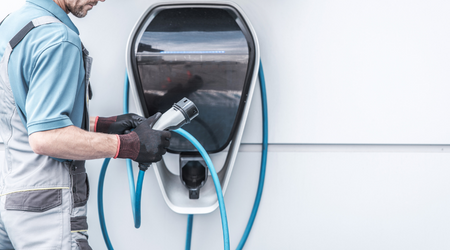
How do EV charging stations work? Level 1, Level 2 and DC fast charge
Electric vehicle charging stations are an essential part of owning an electric vehicle. All-electric cars don't have a gas tank - instead of filling your car with gallons of gas, you simply plug your car into the charging station to refuel. The average electric driver does 80 percent of their car charging at home. Here is a guide to the types of EV charging stations and the likely cost of charging your EV.
Find out how electric vehicle charging stations work, and learn how they differ from standard Level 1 and 2 charging stations
Types of electric vehicle charging stations
Charging an electric car is a simple process: you simply connect your car to a charger that is connected to the mains. However, not all EV charging stations (also known as electric vehicle supplies or EVSE) are created equal. Some can be installed simply by plugging into a standard outlet, while others require custom installation. The time it takes to charge the vehicle also depends on the charger used.
EV chargers typically fall into one of three main categories: Level 1 chargers, Level 2 chargers, and DC fast chargers (also known as Level 3 chargers).
Level 1 EV charging stations
Level 1 chargers use a 120V AC plug and plug into a standard wall outlet. Unlike other chargers, Level 1 chargers do not require the installation of additional devices. These chargers typically have a range of two to five miles per hour and are mostly used in the home.
Level 1 chargers are the cheapest EVSE option, but they also take the most time to charge your car's battery. Homeowners typically use these chargers to charge their cars overnight.

Level 2 EV charging stations
Level 2 chargers are used for both residential and commercial charging stations. They use a 240V (residential) or 208V (commercial) plug and unlike Level 1 chargers, they cannot be plugged into a regular outlet. Instead, they are usually installed by an electrician. They can also be installed as part of a solar panel system.
Level 2 electric car chargers offer a range of 10 to 60 miles per hour of charging. You can fully charge an electric car battery in just two hours. This makes them an ideal option for homeowners who need fast charging and businesses looking to offer charging stations to their customers.
Many electric car manufacturers like Nissan have their own Level 2 chargers.
In Primecom we offer high-quality Level 2 EV charger working within a range of 100V - 240V. Thus providing 3 to 4 Times faster than your manufacture
DC Fast Chargers (also known as Level charging stations)
DC fast chargers, also known as Level 3 charging stations, offer a range of 60 to 100 miles for your electric car in just 20 minutes of charging. However, they are typically only used in commercial and industrial applications - they require highly specialized, heavy-duty equipment for installation and maintenance.
Not all electric cars can be charged with DC fast chargers. Most plug-in hybrid EVs do not have this charging capability, and some pure electric vehicles cannot be charged with a DC fast charger. The Mitsubishi "i" and Nissan Leaf are two examples of electric cars enabled for DC fast chargers.
What about Tesla Superchargers?
One of the big selling points for Tesla electric vehicles is the availability of "superchargers" scattered throughout the United States. Capable of charging a Tesla battery pack in about 30 minutes, these super-fast charging stations are installed across the continental US. However, Tesla Superchargers are designed exclusively for Tesla vehicles. So if you own a non-Tesla EV, your car will not be compatible with Supercharger stations. Tesla owners receive 400kWh of free Supercharger credit every year. This is enough to drive about 1,000 miles.
Shop Tesla Wall Connector for fast charging on Primecom

Leave a comment